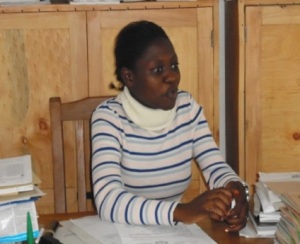Masters and PhD students from NM-AIST, School of CoCSE, visited Nganana and Nambala primary school on 7th March 2014, exactly ten month after the launch of E-reader project in these two schools. NM-AIST students were divided in two groups, first group was to visit the Nambala primary school and second group was to visit the Nganana primary school. For NM-AIST students these visits were a part of their course on ICT and Development, namely ICT for Education. Students were full of enthusiasm to reach Nganana and have a word with headmaster.
This visit was mainly for collecting information about the current situation on the use of E-Readers, the challenges schools facing and how  performance of students and teachers after the introduction of E-readers to their school. The NM-AIST students had a discussion with the assistant headmistress of Nambala primary school asking questions that could help them to prepare a successful E-reader project monitoring and evaluation plan.
performance of students and teachers after the introduction of E-readers to their school. The NM-AIST students had a discussion with the assistant headmistress of Nambala primary school asking questions that could help them to prepare a successful E-reader project monitoring and evaluation plan.
Current Situation with E-readers
The current situation with E-readers at Nganana primary school is that the numbers of pupils have increased from 256 last year to 308 this year. All E-readers are in good condition, none was broken or stolen, and all are in use. All 16 teachers at this school have ability to operate E-reader properly and they help pupils in case of problems. The school allocates a session of 40 minutes every week for students to learn how to use the device. Only students in Standard Three to Standard Seven are using E-readers in their classes.
Problems Facing by the School in E-reader Project
Currently the school is not installed with electric power, this hinder the charging process of the device. They have to take the device to NM-AIST for changing whenever the device battery is down. E-readers are few as compared to number of students (the ratio of 1:2) that was why they are using it only with students from Standard Three to Standard Seven. The teaching model in this school is the use of Swahili language in most of the subjects, except English subject. On the other hand, most of the functions in E-readers are in English language, this hinders the pupils to master the use of the device quickly.
The Success in the Use of E-readers
One of the positive outcomes of the E-readers project is the increased of pupils attendance in classes. During the E-reader session the attendance is higher as compared to other sessions. The assistant head teacher stated that “pupils are happy to use E-readers because it is just electronic device”. She also admits that “if you put a printed book and E-reader on the table and ask pupils to choose, they will all run to E-readers”. This motivates the reading, makes reading so interesting to them and through that motivation of pupils and their reading ability have increased, especially for slow learners.
higher as compared to other sessions. The assistant head teacher stated that “pupils are happy to use E-readers because it is just electronic device”. She also admits that “if you put a printed book and E-reader on the table and ask pupils to choose, they will all run to E-readers”. This motivates the reading, makes reading so interesting to them and through that motivation of pupils and their reading ability have increased, especially for slow learners.
Recommendations from Assistant Headteacher
First she acknowledged the importance of using E-readers in primary schools because of the success her school obtained due to the use of E-readers. She requested the addition of more E-reader devices so that they can be able to use with students from nursery to Standard Seven. She  also requested the installation of electric power to the school so that the charging of the device could be easy. Finally, she recommended the arrangements of books in E-reader device to be grouped in class level to help students to find the required book easily. Assistant head teacher at Nganana primary School, Ms. Ceaser admitted the importance of E-reader to her school.
also requested the installation of electric power to the school so that the charging of the device could be easy. Finally, she recommended the arrangements of books in E-reader device to be grouped in class level to help students to find the required book easily. Assistant head teacher at Nganana primary School, Ms. Ceaser admitted the importance of E-reader to her school.



NIce one, and They do a wonderful job, at least the findings will be good input to the sustainability of the project.